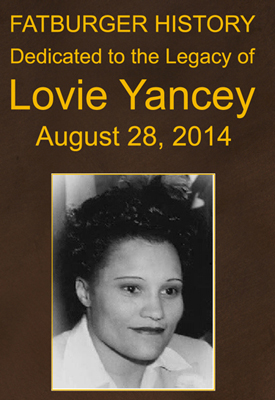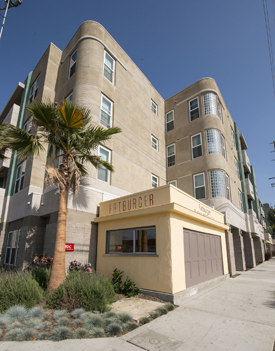Fatburgers!
- Details
- Category: Our History
- Published on Friday, 06 February 2015 15:40
- Written by Carla Pineda
 How would you describe the most epic burger you’ve ever had? “Delicious,” “juicy,” and of course, “fat” are all used to describe a meal at Fatburger, an international fast-food restaurant rooted in the heart of Los Angeles. But anyone who was lucky enough to visit the original Jefferson Park location will tell you today’s fancy franchise burgers are nothing compared to the hand-slapped patties grilled in the three-stool stand.
How would you describe the most epic burger you’ve ever had? “Delicious,” “juicy,” and of course, “fat” are all used to describe a meal at Fatburger, an international fast-food restaurant rooted in the heart of Los Angeles. But anyone who was lucky enough to visit the original Jefferson Park location will tell you today’s fancy franchise burgers are nothing compared to the hand-slapped patties grilled in the three-stool stand.Growing up, Larry Harris heard stories from his dad about the great food that came from “a literal hole in the wall.”
“Back then it was a hang out spot,” Harris said. “And you always had to be ready to wait because it was constantly busy. But it was well worth the wait.”
Lovie Yancey opened Mr. Fatburger in 1947 and dropped the “Mr.” in 1952. The hands-on founder ran this stand as her only location for decades before expanding in the 1980s and eventually selling the company in 1990. After selling the company, she kept ownership of the original stand for another decade.
“This location was a pillar in the community and it transformed Lovie’s life by not only being a great business venture but by becoming a culturally significant part of the community,” said Thayer Wiederhorn, vice president of marketing for Fatburger.
The original restaurant was located on Western Avenue between 30th and 31st Streets – territory that runs into the blurry borders of South Los Angeles. When the stand opened, the neighborhood reflected issues faced by the entire nation.
“It was 1952; racism, segregation and prejudice was still prevalent in the U.S.,” Wiederhorn said.
Some neighbors recall the final years of the stand in a not-so-positive light.
“The area was sketchy,” said Louis Gonzales. “I remember lots of thugs hanging out next to it because of the bus station.”
Yet, the stand stayed open for decades and is remembered nostalgically by most who had a chance to visit it.
Their burgers were “very sloppy” and the patties formed from fresh ground beef stored in white buckets were “extra fat.” Their menu included franks, hot links, and chili. Although Yancey refused to add fries, she served homemade sweet potato pie.
In the early 1960s through the 1970s, you would find celebrities grabbing late-night meals at Fatburger. The restaurant’s star-studded customer list – including Isaac Hayes, Wilt Chamberlain, and Rudy Ray Moore – grew even more when Yancey opened a second location on San Vicente and La Cienega Boulevards.
“[Due to] the cultural significance of the original stand and her brand, a lot of the celebrities were actually her loyal customers,” Wiederhorn said.
The restaurant’s authenticity declined as the number of franchises grew in the 1980s when the Yancey children began taking over and expanding, recalls Jonathan Jose Jackson III, a Pasadena-based fan from Roadfood.com who has Fatburger memories dating back to his pre-teen years in the late 1950s.
The 1990s and 2000s marked a new era for the restaurant, with celebrities such as Magic Johnson and Kanye West opening franchises nationwide, and rappers such as Ice Cube, Notorious B.I.G., and Tupac dropping the name in their rhymes. More recently, the chain was in headlines because rapper T.I. and boxer Floyd Mayweather got in a fist-fight at the popular pre-hangover venue of choice for partyers entering the first circle of Las Vegas hangover hell.
In the past few years, Fatburger has exploded internationally under the direction of Wiederhorn, who seems to have a nose for profit – and turmoil. The chain has expanded into conflict-prone countries, such as Iraq, Eqypt, and Pakistan. Now that the U.S. is restoring diplomatic relations with Cuba, the company has its sights on becoming the first U.S. franchise to land on the island.
“Consumers all over the world love American brands, especially burgers, shakes, and fries,” he told Businessweek. “I knew there was a huge opportunity for us overseas.”
Locally, the restaurant has a new location at Crenshaw and Slauson Boulevards and the chain began expanding into Northern California as of 2014.
Today, the framework of the original stand has been restored and remains within Jefferson Park Terrace, a new affordable housing development built on site. It is currently closed to protect it from the vandalism that was deteriorating the shutdown stand before construction began, according to Ben Phillips, project developer for Mercy Housing.
 “The original tiny hamburger stand has been incorporated into the building’s design and has been preserved as a beacon of Black entrepreneurship in the Jefferson Park neighborhood of Los Angeles,” said Mercy Housing in its news release announcing the August 2014 opening of the apartment community for low-income families and those living with HIV/AIDS. The building was dedicated to the legacy of Yancey.
“The original tiny hamburger stand has been incorporated into the building’s design and has been preserved as a beacon of Black entrepreneurship in the Jefferson Park neighborhood of Los Angeles,” said Mercy Housing in its news release announcing the August 2014 opening of the apartment community for low-income families and those living with HIV/AIDS. The building was dedicated to the legacy of Yancey.“We are interested in any sustainable ideas people may have for future use of the stand,” Phillips said.
Mercy Housing is open to explore any ideas for the building, such as a museum, as long as they come with funding to sustain operations.
Categories
-
Architecture
IF ONLY WALLS COULD SPEAK!
 People often think of history as an impersonal collection of facts and dates, a dusty inventory...
People often think of history as an impersonal collection of facts and dates, a dusty inventory...
-
Our History
BRIDGET "BIDDY' MASON: Founder of the First African American Methodist Church FAME
 Originally posted on blackdoctor.orgWhen we talk about Black History, we hear a lot of names over...
Originally posted on blackdoctor.orgWhen we talk about Black History, we hear a lot of names over...
-
In Memory Of
Barbara Morrison Celebrated Jazz Singer Dies at 72
 Barbara Morrison, a legendary singer in the Los Angeles jazz and blues music community, has died....
Barbara Morrison, a legendary singer in the Los Angeles jazz and blues music community, has died....
Today7
Yesterday10
Week7
Month117
All988735
Kubik-Rubik Joomla! Extensions
Yesterday10
Week7
Month117
All988735
Currently are 20 guests and no members online
Kubik-Rubik Joomla! Extensions




